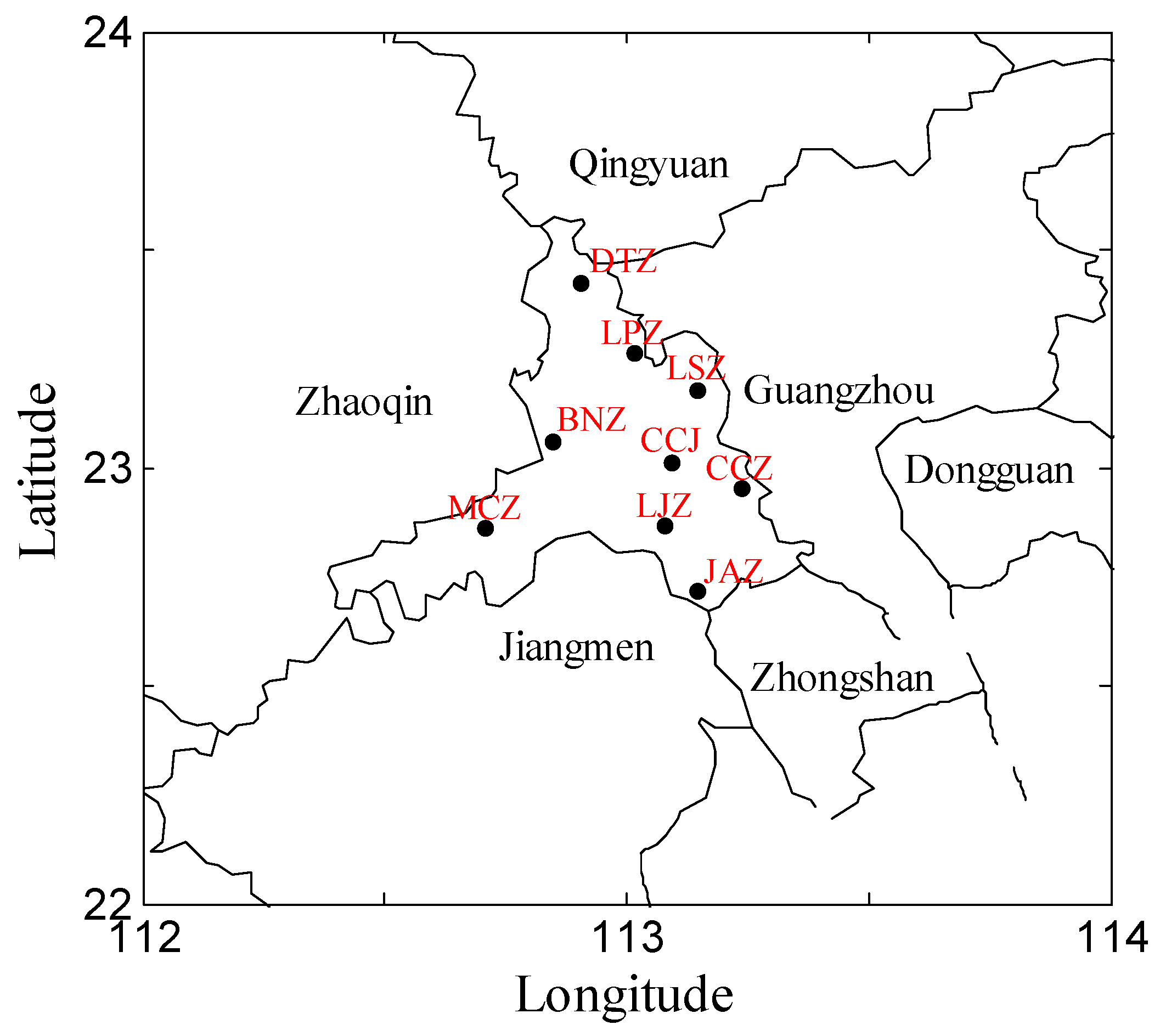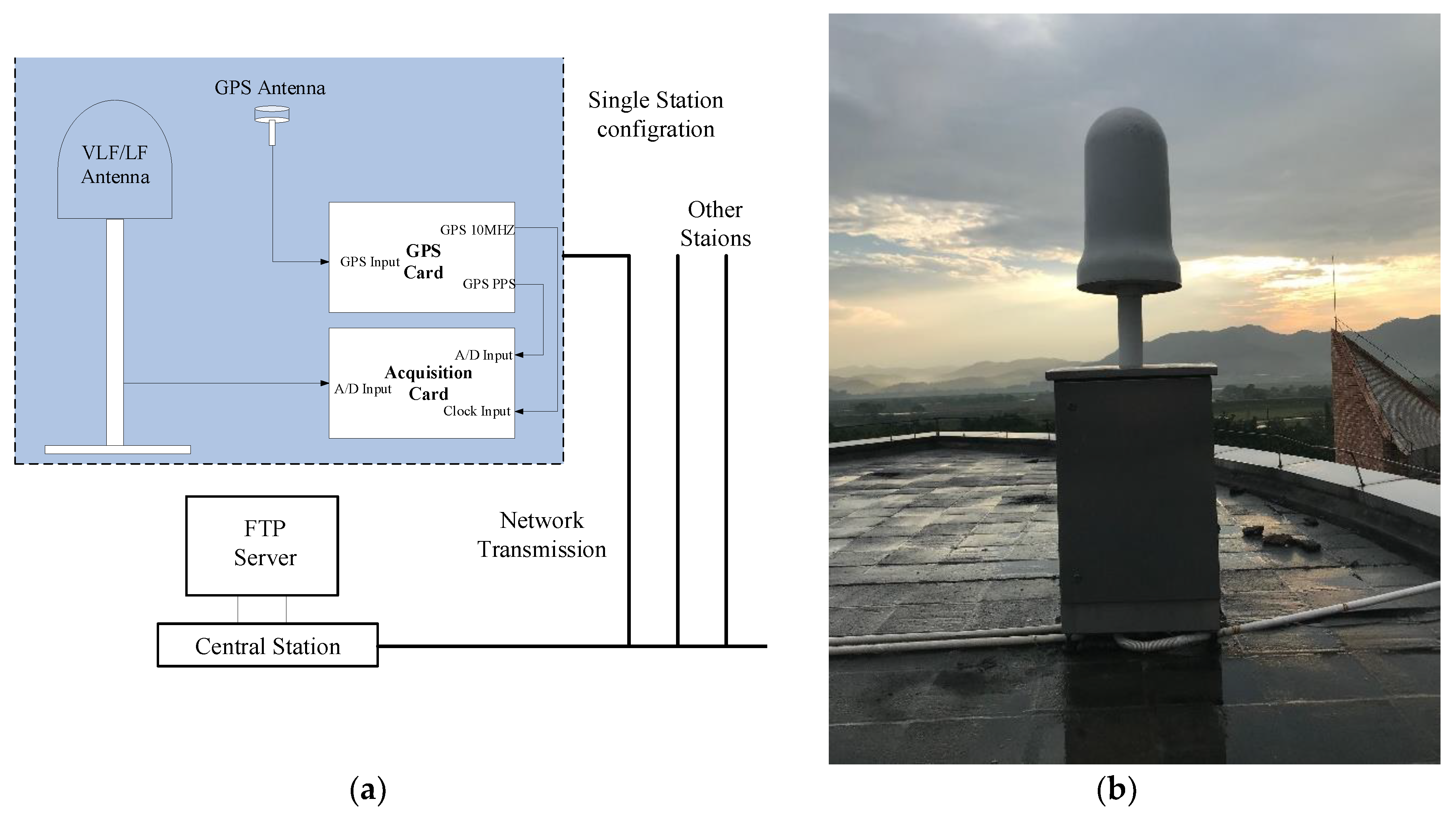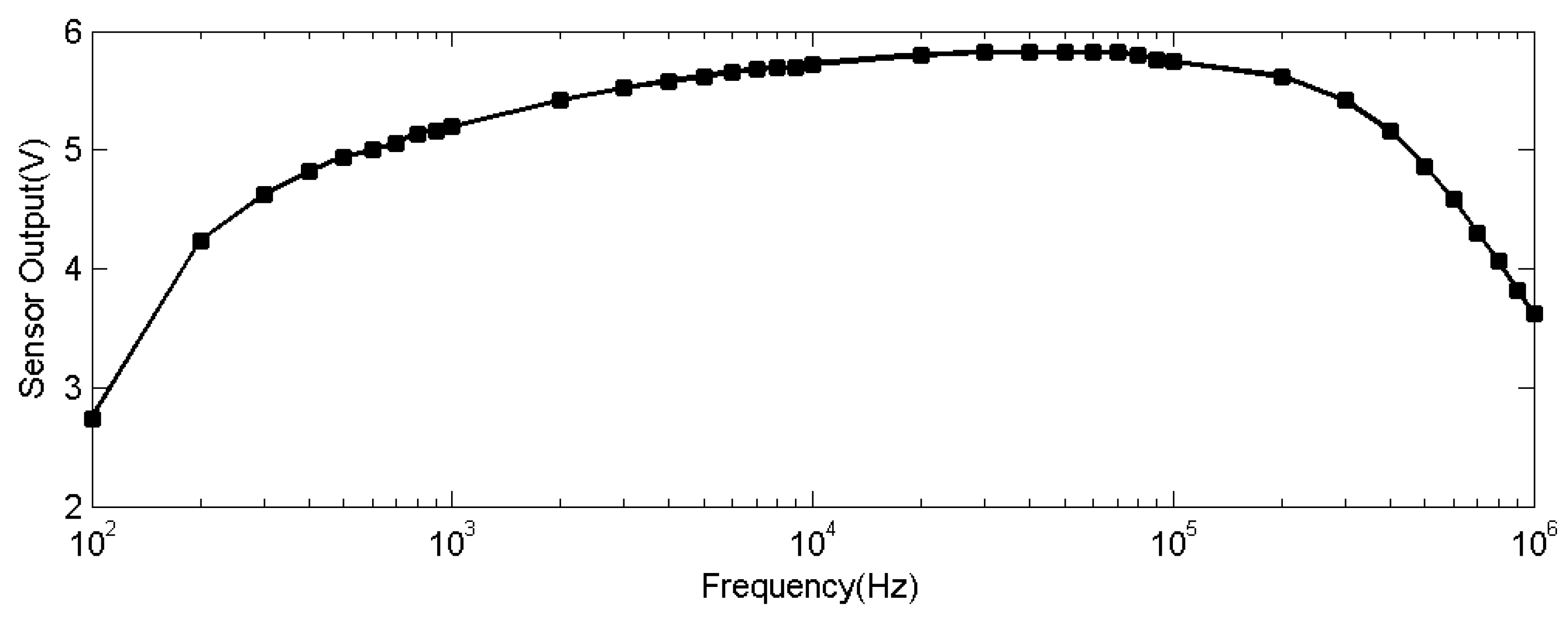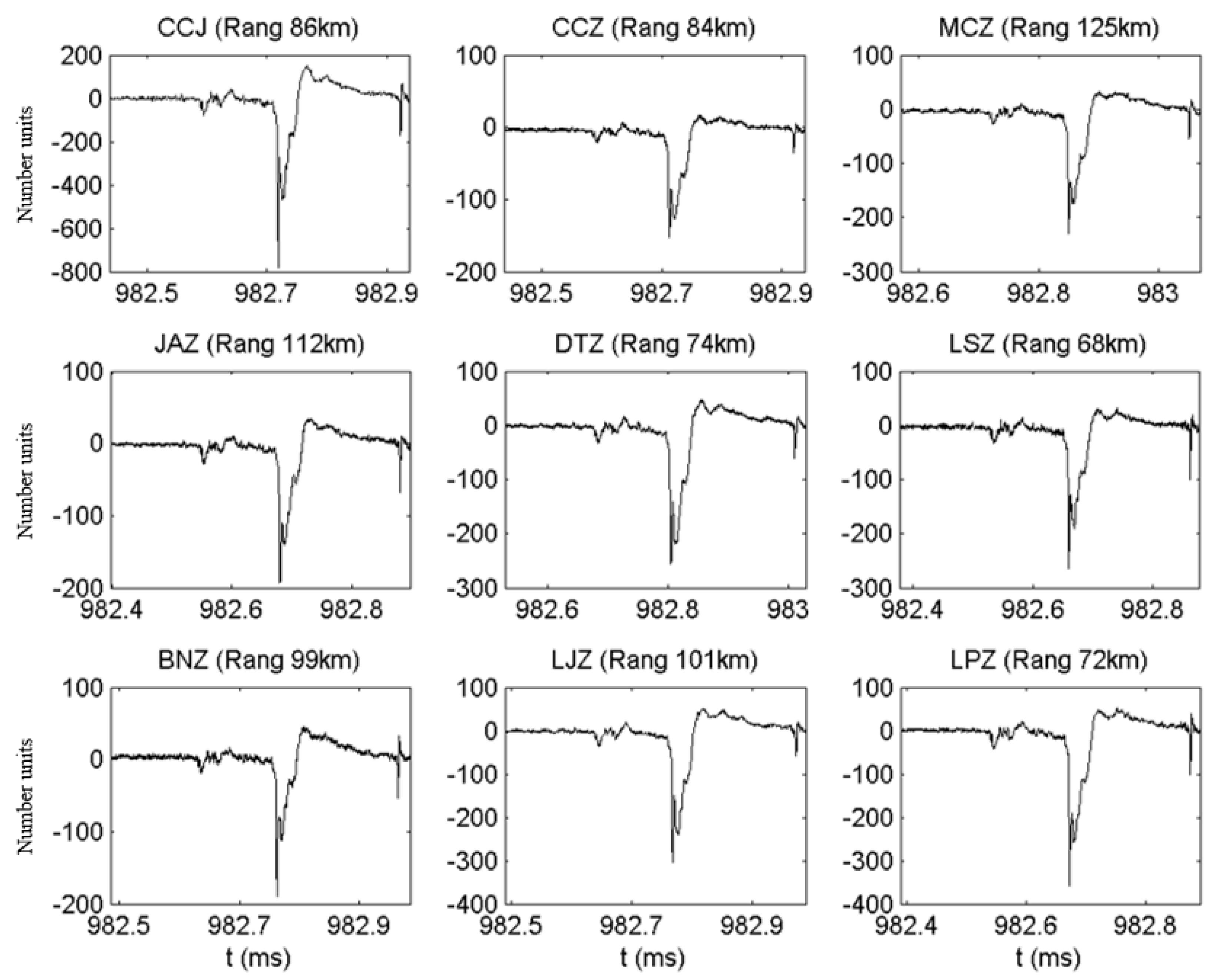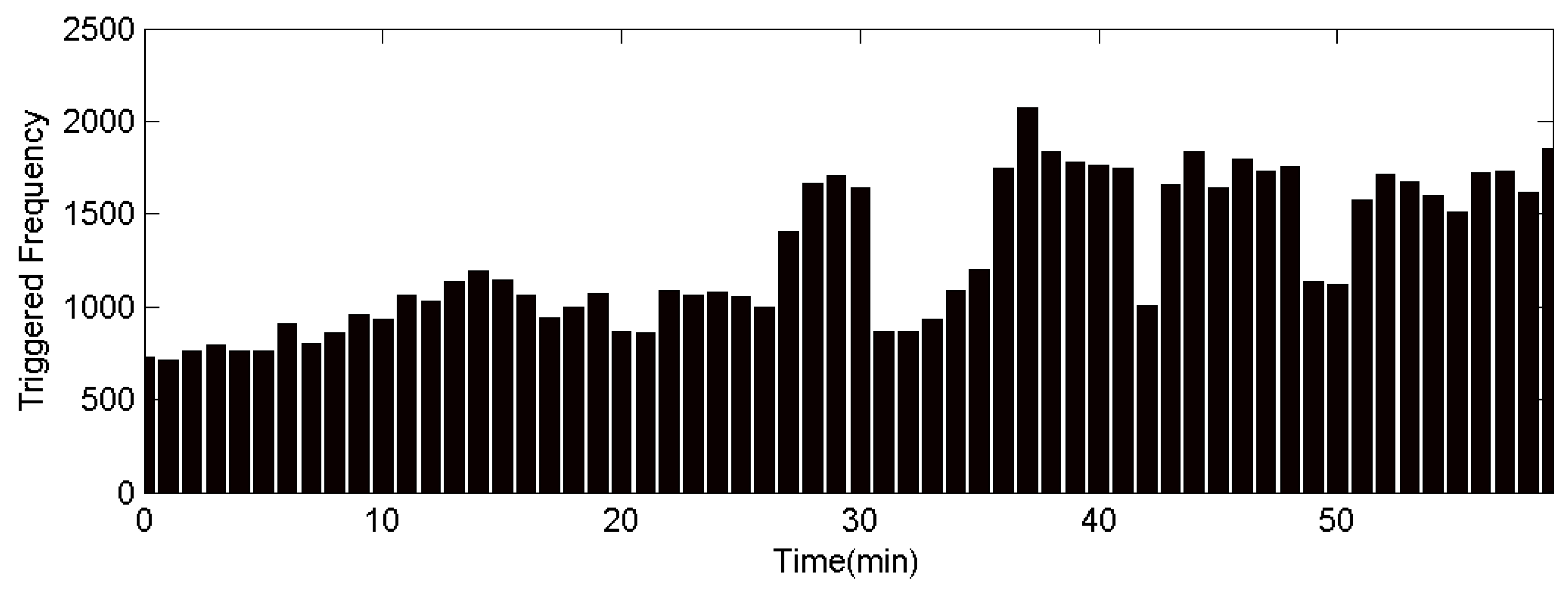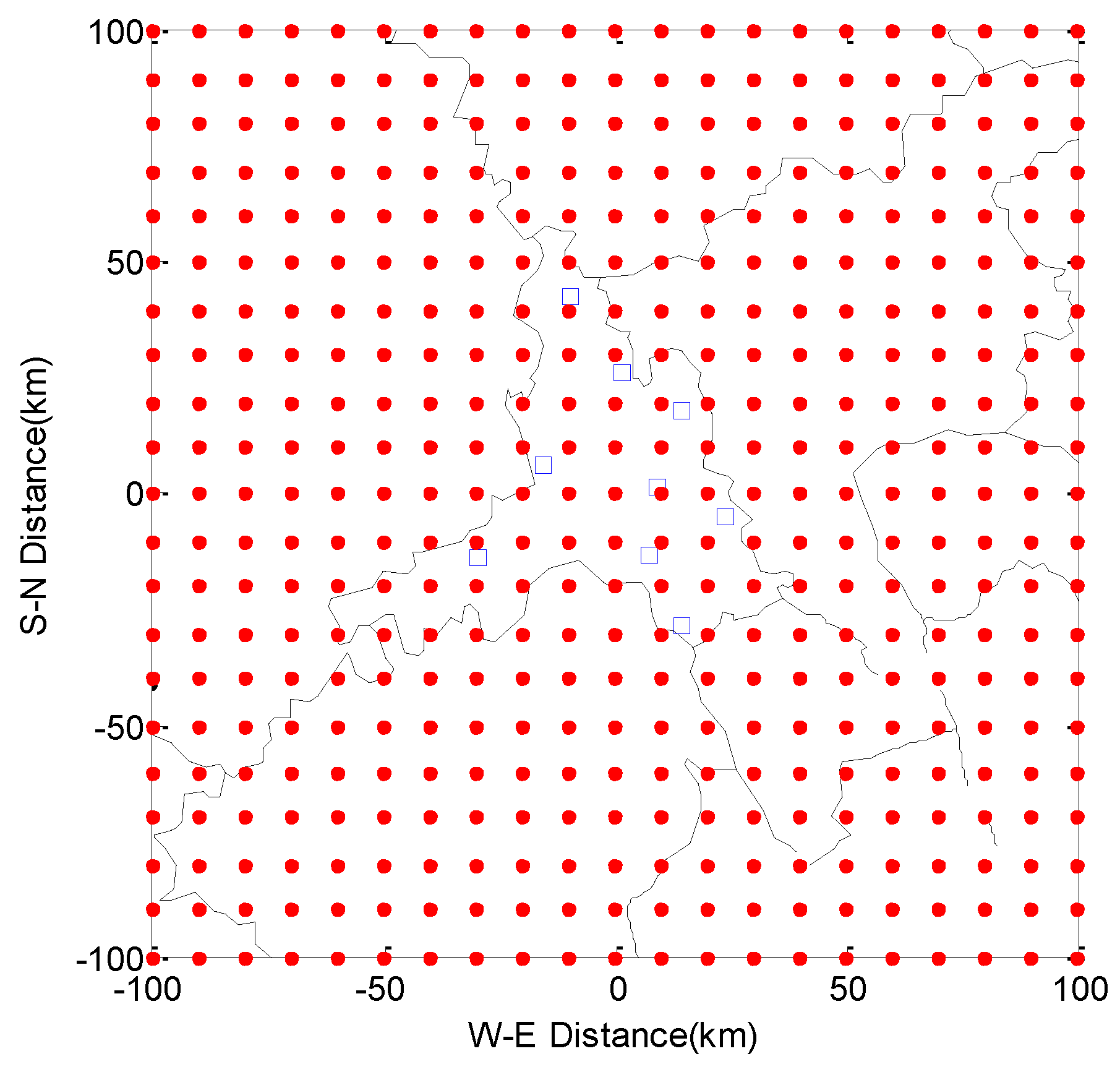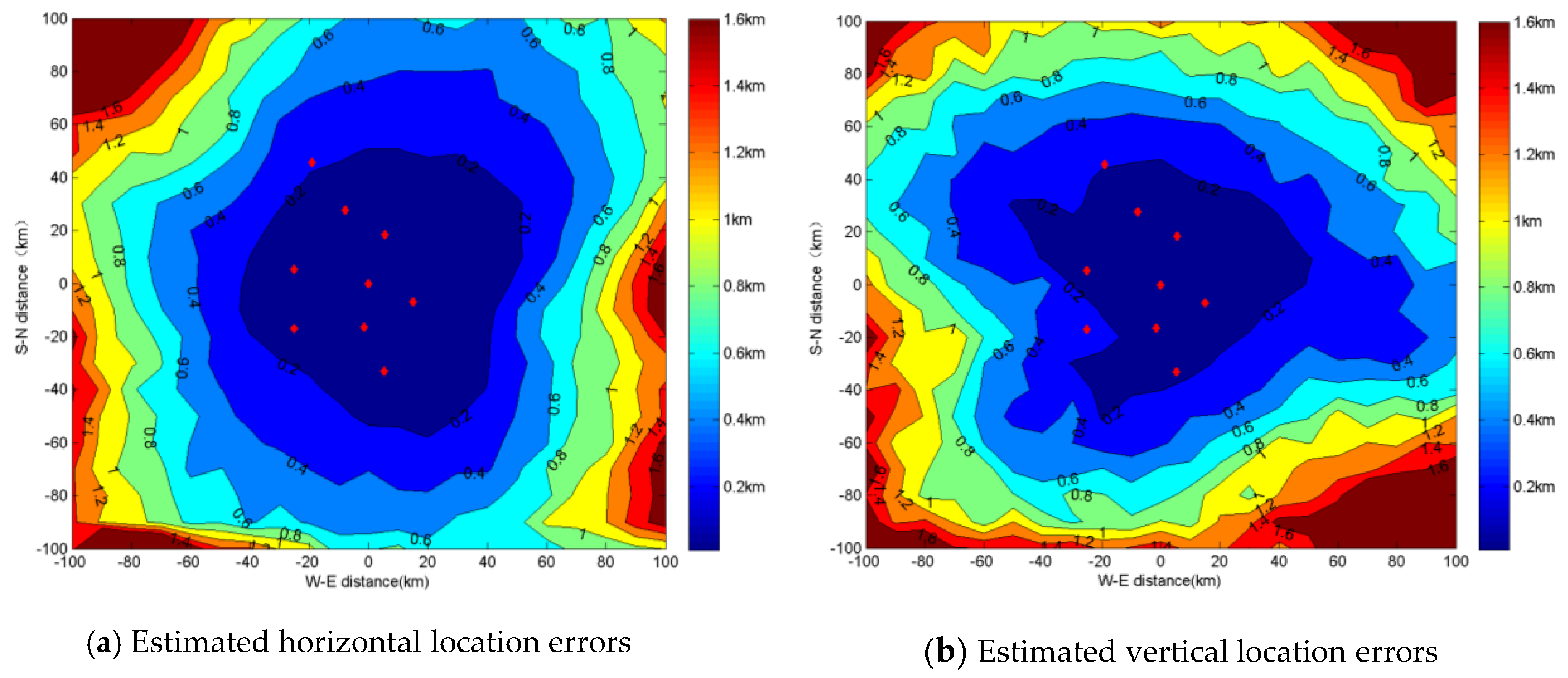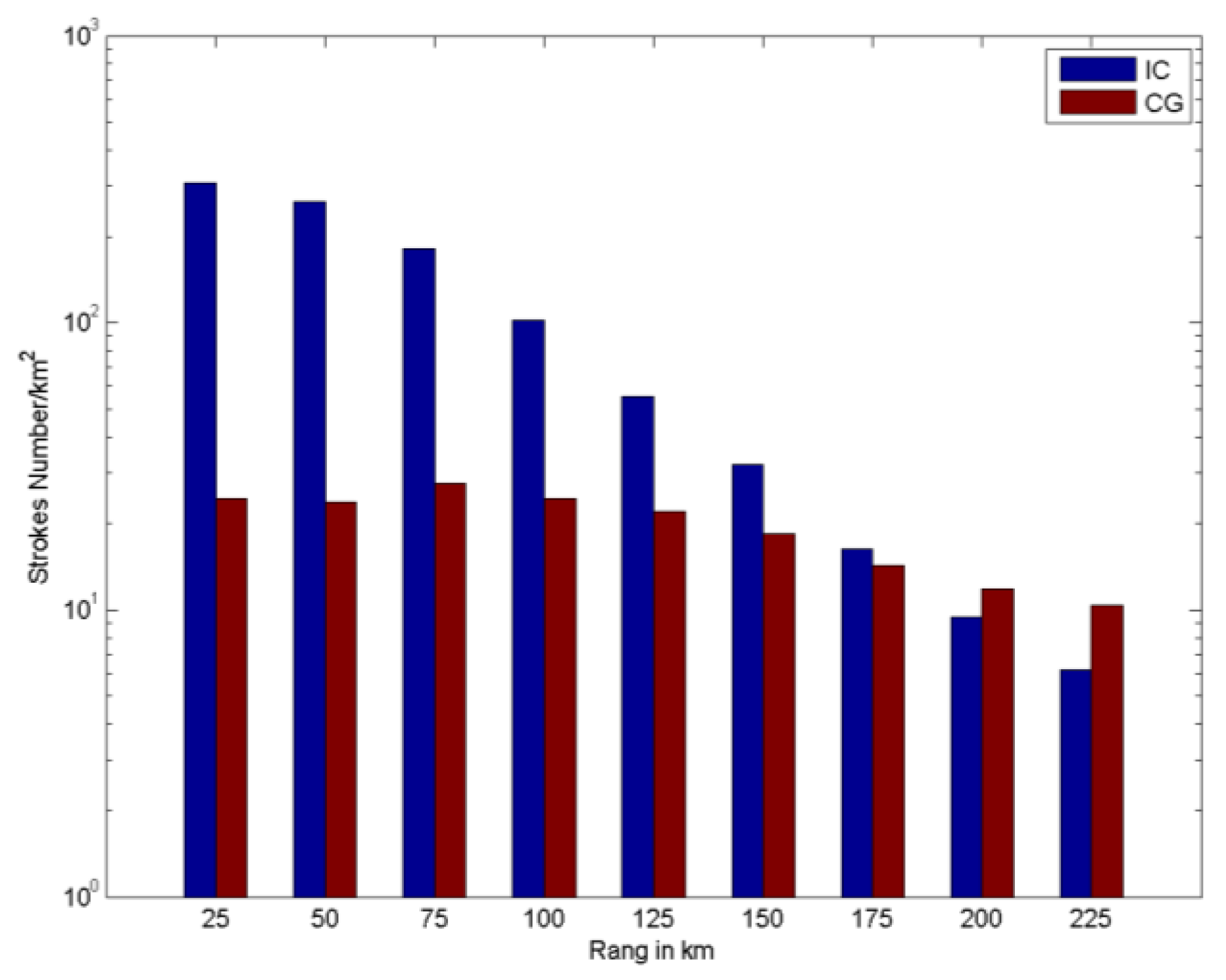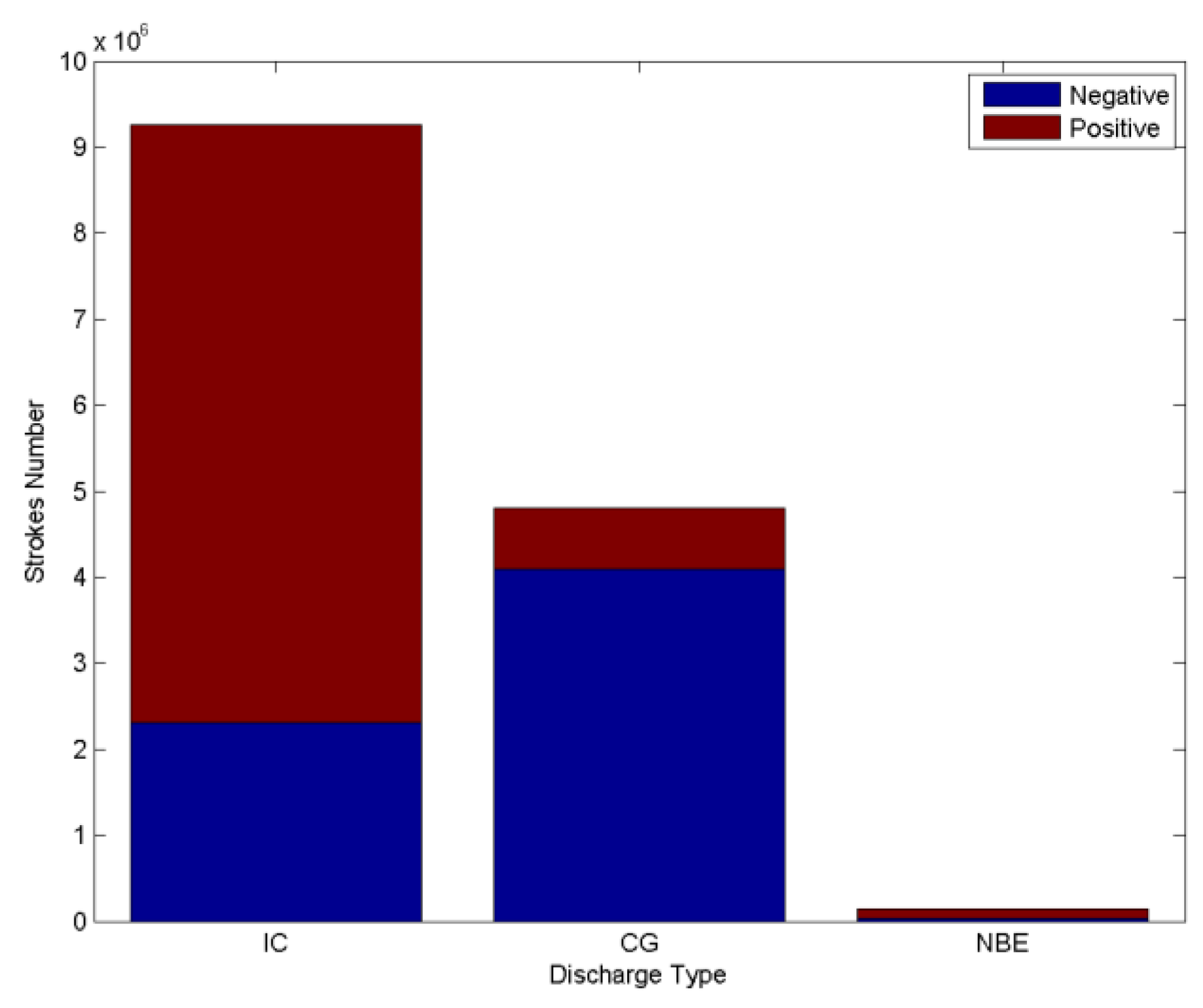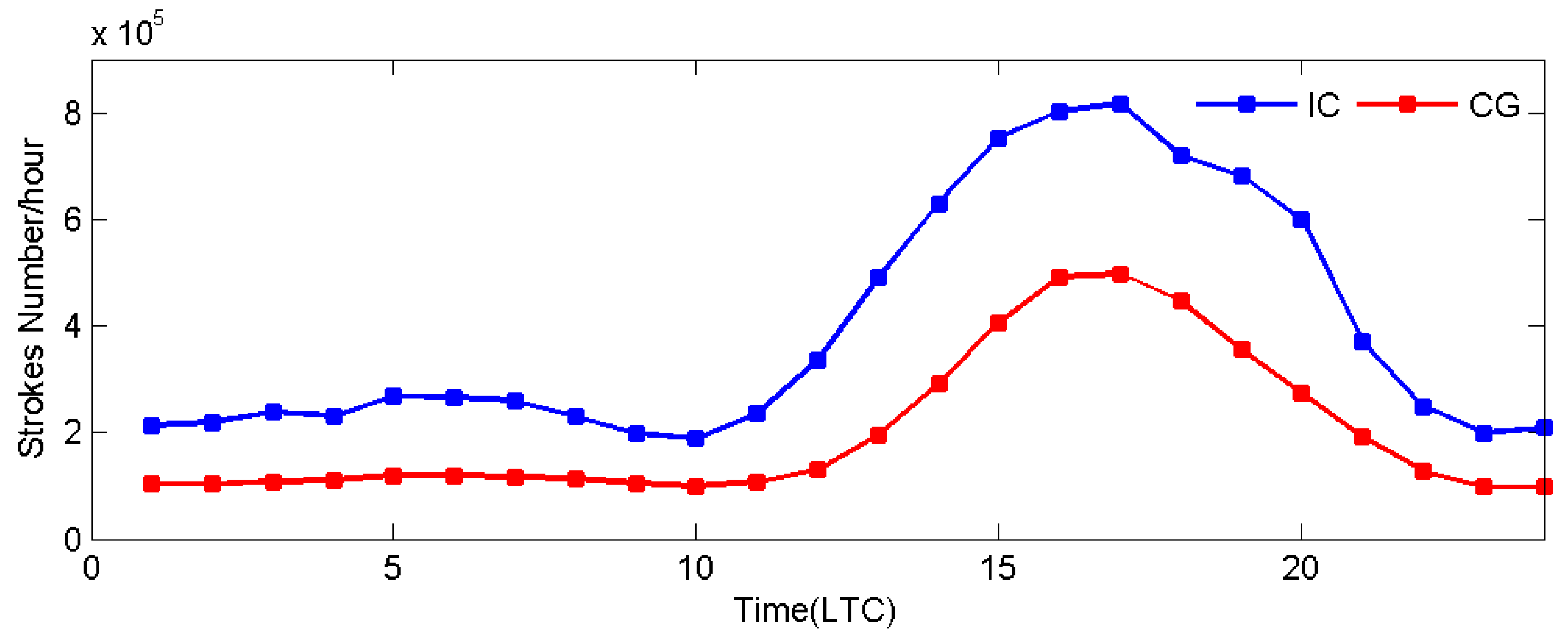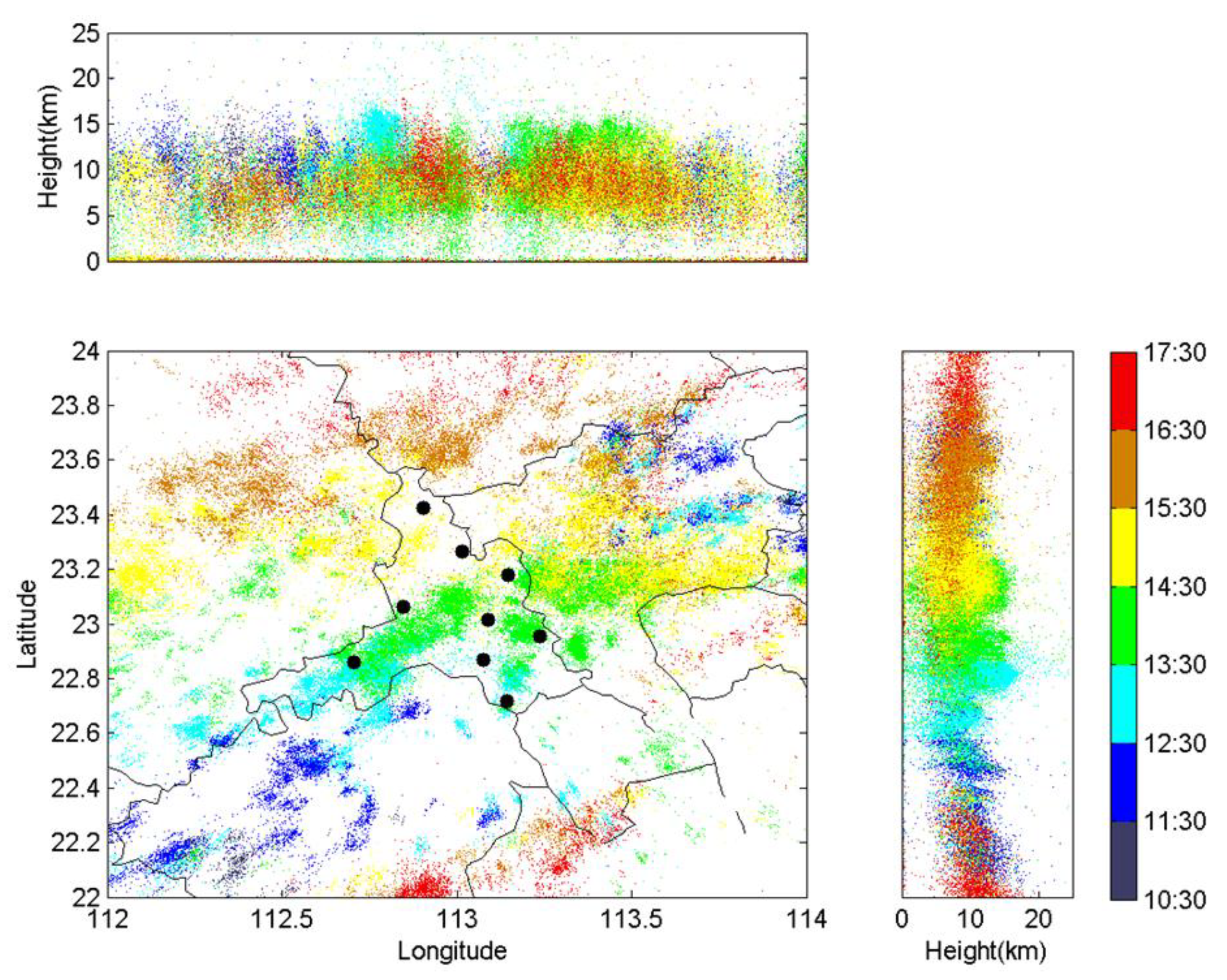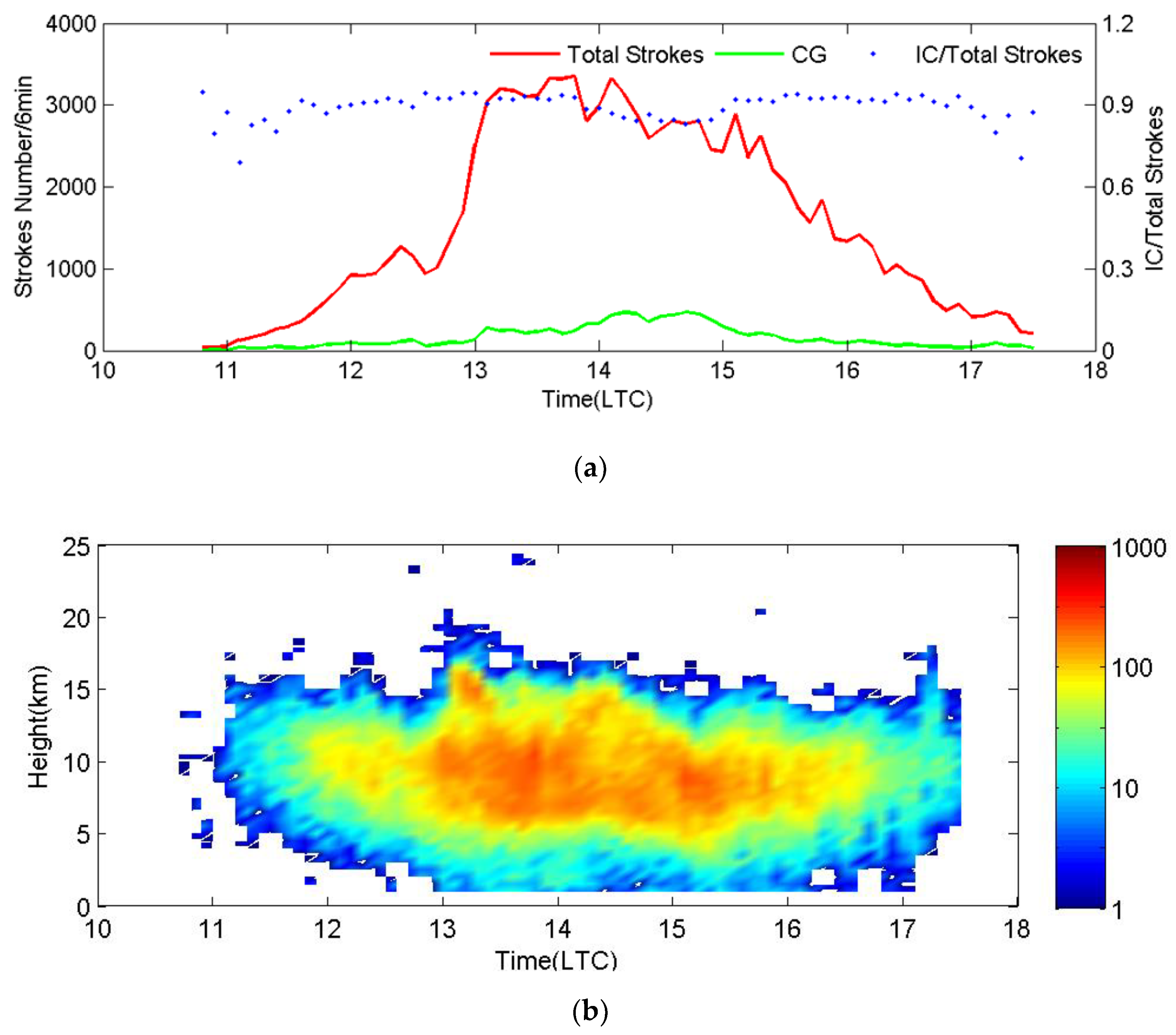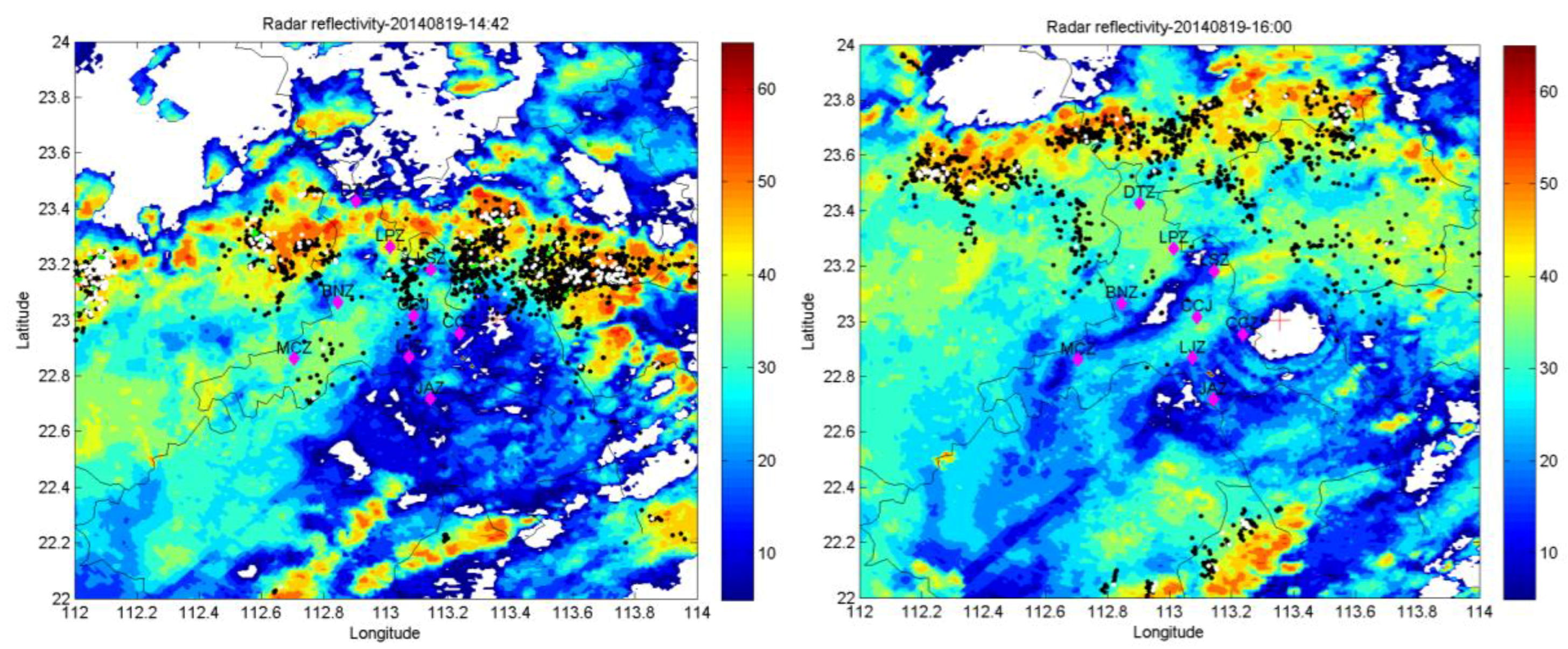1. Introduction
Lightning location systems (LLSs) can be classified as being either satellite-based or ground-based depending on where the sensors are installed [
1]. Different from LLSs installed on satellites in polar orbits [
2], the ground-based LLSs are continuous on lightning location, which provides extensive applications in studying lightning flash processes and monitoring thunderstorms. Electromagnetic field location technology adopting the time of arrival (TOA) method based on the low and very low frequency (LF/VLF) bands has been developed rapidly in recent decades [
3]. The two-dimensional (2D) locations and estimated current peaks were accessible through a traditional LF/VLF lightning detection network. On the other hand, identification technology of lightning (i.e., intra-cloud lightning (IC), cloud-to-ground lightning (CG), and narrow bipolar events (NBEs)) in the LF/VLF frequency band has been developed rapidly, which supports the current work of updating of previously-focused CG detection of LLSs.
Nowadays, various institutions in the United States, Japan, and Germany have conducted three-dimensional (3D) detection technology research on lightning for a clearer understanding of its occurrence and its development mechanism inside [
4,
5]. The Los Alamos Sferic Array system (LASA), established in 1998 in New Mexico State to provide lightning demarcation in cooperation with satellite observation working at LF/VLF frequency and developed by the Los Alamos National Laboratory (LANL), is capable of high-precision 3D location of total lightning discharge [
6,
7]. Similarly, working on the LF/VLF bandwidth, Karunarathne [
8] developed a fast antenna network called the Position by Fast Antenna (PBFA) system operating in the frequency band of 1.6–630 kHz to locate the lightning process, using the time of arrival (TOA) technique, which consists of ten observation sub-stations. The location results show that PBFA has the advantage of capturing pulse information in the initial phase of lightning. On the other hand, a 3D lightning radiation source location system working at very high frequency (VHF), the LMA system, developed by New Mexico Mining Technical College of the USA, adopted DTOA techniques based on GPS clock synchronization for lightning positioning [
9,
10]. Bitzer [
11] successfully mapped the development of single lightning flashes and cloud lightning flashes based on the Huntsville Alabama Marx Meter Array (HAMMA) in the United States with a detection frequency from 1 Hz to 400 kHz. Comparing the HAMMA data with those from two other well-documented arrays, namely the North Alabama Lightning Mapping (NALMA) in the VHF band and the NLDN in the VLF/LF band, HAMMA can match the location results of NALMA in time and space for the development of lightning channels. In addition, HAMMA can locate more impulse information than NALMA in the initial phase of lightning.
In Japan, Yoshida [
12] made a network (with a working frequency of 800 Hz to 500 kHz) known as the Broadband Observation network for Lightning and Thunderstorm (BOLT), which results have shown is able to describe the developing characteristics of IC and CG flashes. Betz set up a lightning location system (LINET) similar to LASA in Germany, which can distinguish between IC lightning and CG lightning according to the heights of lightning radiation sources. The determination of source altitude is done with the quasi-3D technology of the sensor that’s closest to the lightning source [
13,
14,
15,
16].
Considering the above motivations for elevating the applications of lightning data to research on atmospheric electricity, in 2013, we established the FTLLS based on DTOA techniques [
17] in the Foshan area, Guangdong Province, China. In this paper, we document the configuration and setup information of the FTLLS in detail, evaluate its performance and describe its initial operation in 2014. The observation results mentioned in the study serve as a vital reference information of FTLLS.
4. Location Error
The location error of the station network is closely related to the geographical distribution of the station network. In order to estimate the location error, the Monte Carlo method based on the “random number” for a simulation of the location errors of the network covered area is adopted in this paper. Specifically, as shown in
Figure 8, the CCJ station was adopted as the center and an area consisting of 200 km × 200 km were gridded in detail. The step length was set to 10 km. A total of 441 grids within this area were simulated individually through the Monte Carlo method.
Firstly, based on radiation transmission equation, we calculate the exact arrival time at each station of the simulated discharge event that occurred at each grid. Then, a random error from a normal distribution with a mean of 0 us and a variance of 200 ns is added to the arrival time at each station. Through linear and non-linear least square approximation, we simulate the inversion position and time of occurrence of the discharge events. Finally, the difference between the inversion position and the real position is calculated, which is recorded as the location error of this grid.
Repeating above mentioned steps for 1000 times, we can obtain 1000 times of the location errors for this grid, and the mean value of the 1000 times of the location errors is recognized as the final location error.
In the simulation, assuming that the radiation source is at an altitude of 10 km, and all nine sub-stations have detected simulated discharge events and have taken part in the location, then conduct 3D location inversion. The inversion errors include the two-dimensional horizontal error and vertical error, which are expressed as follows:
where (
) is the actual 3D coordinates of the simulated radiation source, and (
) is the corresponding 3D coordinates calculated by DTOA algorithm.
Figure 9 indicates the estimated horizontal and vertical errors for the radiation source at an altitude of 10 km.
When the lightning event occurs within the network, the two-dimensional horizontal location error is basically less than 100 m, and the vertical error is mostly less than 200 m, which indicates FTLLS has a high precision for the lightning location within the station network. However, due to the fact that the Foshan area is located within the station network, the FTLLS can assist in searching for lightning strike points when lightning directly strikes on power transmission lines in the power distribution network of the Foshan area. When the lightning event occurs outside the network, the location errors gradually increase as the distance increases. The average horizontal error within a distance of 100 km is less than 1.5 km, and the corresponding vertical error is less than 1000 m. Obviously, FTLLS can locate the lightning radiation source within a distance of 100 km in the Foshan area accurately, from which the data provides valid reference information for analyzing lightning strike faults on power transmission lines.
5. Initial Operation Results
Nevertheless, the FTLLS is not able to map the lightning channel structures in detail like the VHF DTOA techniques [
9,
10] and interferometer system [
19], because of the LF/VLF signals observed. The VHF systems detect the radiation signals produced by smaller-scale breakdown processes, whereas the FTLLS detects the field changes that are produced by larger-scale breakdown processes. In spite of no detailed channel structure, the FTLLS can monitor overall storm development with the height and rate of the radiation sources. In addition, the FTLLS can pinpoint the ground strike points of CG strokes and can readily distinguish between IC events, CG events and NBEs. Electric field changes produced by either CG events or IC events are indiscriminately captured and processed by the FTLLS.
Figure 10 shows the number distributions of the located strokes of the two types as a function of distance, based on six months’ observations from May to October in 2014. As shown in the figure, only those lightning flashes that occurred within a 225 km range were considered for the analysis. Each bin represents a normalized number of strokes that occurred within a 25-km-wide concentric ring around the center station (CCJ). It is shown that 4–10 times more ICs were detected than CGs within the distance range of 100 km, as the distance range increases to 200 km and beyond, there were more CGs detected than ICs, which is in general agreement with the previous report that indicated the LASA system detected 2–5 times more ICs than CGs within the range of 100 km and saw more CGs than ICs when the range increases to 200 km and beyond in north-central Florida [
7]. The general disparity between return stroke currents and weaker IC discharge currents could be one of the apparent reasons.
Over 14 million lightning strikes were recorded by FTLLS from May to October in 2014, among which over 9 million strokes were IC events, 4.8 million strokes were CG events, and 140 thousand strokes were NBEs. The proportion of different types of lightning from May to October in 2014 is represented in
Figure 11. The percent of IC events, CG events and NBEs are 65%, 34% and 1%, respectively. The ratio between positive CG and negative CG is 0.17, while the ratio between positive NBE and negative NBE is 2.9. Moreover, there is an excess of positive polarity (+IC) events compared to negative polarity (−IC) events. In addition, the characteristics of thunderstorm activities presented by FTLLS are vital for monitoring thunderstorm weather. Specifically, the average number distribution of lightning hourly frequency is shown in
Figure 12, in which the times of highest lightning frequency are mainly from 12:00 to 19:00, indicating the strong convection activities generally in Foshan area. It is worth noting that there is no significant difference between CG events and IC events in hourly frequency distribution.
Meanwhile, the FTLLS is capable of a fine 3D location,
Figure 13 shows the evolution process of an overhead thunderstorm mapped by the FTLLS on 19 August 2014 during a 60-min interval, which moved from West to East and lasted for around 7 h during 10:30 to 17:30 LTC. The entire occurrences and development processes of the thunderstorm were well mapped by the FTLLS. One hundred and six thousand, seven hundred and eighty-nine lightning events were located by the FLLLS in total, among which 95,060 events were IC events (66,754 +IC and 28,306 −IC), 10,726 events were CG events (2,650 +CG and 8,076 −CG), and 1003 events were NBE events ((706 +NBE and 297 +CG), respectively. The time series of lightning frequencies (containing total lightning, CG and IC-ratio) during the entire thunderstorm process with a time interval of 5 min for the period 10:30–17:30 LTC (local time = UTC + 8 h) is represented in
Figure 14a. The most intense peak intensifies at about 13:30 LTC when IC events numbers increase rapidly, while a smoother manner was shown in the distribution of CG events changes. The IC-ratio defined as the ratio of IC events numbers and the total stroke numbers, which were continuously large throughout the thunderstorm process. In particular, the IC-ratios were larger than 0.8 most of time, indicating the dominant role of the IC events accounting for at least 80% of all strokes.
Unlike the two-dimensional location, an additional altitude parameter is recognized as a unique feature of 3D-based lightning location systems. The heights of IC events are also clearly exhibited in the vertical cross section in
Figure 14b. As shown in
Figure 14b, all IC events occurred at an altitude below 25 km, high IC densities extended through the altitude interval between 7 km and 12 km, and almost 90% of IC events occurred at an altitude below 15 km. For example, Shi [
1] showed 3D lightning pulse discharge events of an IC flash that occurred at 16:26:24 (BT) on 15 August 2015, in which the location heights were separated into two layers with average heights of 5 and 10 km. Practically, the space at an altitude above 25 km is recognized as the stratosphere and shows little lightning activity, which is in general agreed upon with the observation results of the FTLLS.
In order to verify the rationality of thunderstorm location, the radar–lightning comparison in a horizontal section for the period 12:00–16:00 (LTC) on 19 August 2014 is shown in
Figure 15, corresponding to four stages of thunderstorm, namely: lightning appearing period, lightning development period, lightning fully developed period and lightning leaving period, respectively. When the lightning data is compiled for appropriate time intervals excellent agreement is obtained with radar reflectivity. The radar information in the paper is provided by the Guangzhou Radar, which is the Doppler weather radar with S-band and works in volume scan mode. During the thunderstorm period, in the area where the radar echo is strong, the convection activity is frequent, and the corresponding detected lightning frequency is quite large, prominent areas of higher reflectivity exhibited dominant IC events and CG events. The location results of CG events exhibited more consistently with the radar reflectivity compared to IC events. Moreover, NBEs concentrated in the lightning development period and lightning fully developed period, which were always accompanied with CG strokes.
6. Conclusions
A detailed working principle and observations of the Foshan Total Lightning Location System (FTLLS) were presented. In this paper, the geographical distribution and set-up information of the FTLLS, the estimated locating errors and locating results, as well as its initial operation results were presented. The working bandwidth is from 200 Hz to 500 kHz. Specifically, location algorithms and discharge type recognition were shown. Based on Monte Carlo simulations, the two-dimensional horizontal location error is basically less than 100 m, and the vertical error (altitude) is less than 200 m when the lightning event occurs within the network, while the average horizontal error within a distance of 100 km is less than 1 km and the corresponding vertical error (altitude) is less than 700 m. On the other hand, over 14 million strikes were recorded successfully by the FTLLS during the period of May to October in 2014, among which IC events, CG events and NBEs accounted for 65%, 34% and 1%, respectively. It is shown that the FTLLS is capable of fine three-dimensional (3D) location, in which the altitude parameters obtained are reasonable and consistent with observed data in the previous studies. The location results of thunderstorms were additionally verified through simultaneously-observed radar data.
Due to its fine three-dimensional (3D) location and lightning electric field waveform record function, the FTLLS was mainly used in the analysis of three-dimensional activity characteristics of typical thunderstorms in the Foshan area, inquiry of lightning strike faults on transmission lines and waveform analysis of radiated electric field in different distances and so on.
